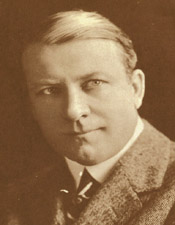King Baggot (King Baggot)

Actor, Director, and Screenwriter. He is remembered as an internationally famous movie star of the silent era and the first individually publicized leading man in the US. He was often referred to as “King of the Movies,” “The Most Photographed Man in the World,” and “The Man Whose Face Is As Familiar As The Man In The Moon.” He appeared in over 260 films from 1909 to 1947, of which he is best known for “The Scarlet Letter” (1911), “Dr. Jekyll and Mr. Hyde” (1913), and “Ivanhoe” (1913). He wrote 18 screenplays, and directed 45 movies from 1912 to 1928, including “The Lie” (1912), “Raffles” (1925), and “The House of Scandal” (1928). Born William King Baggot, his father emigrated from Ireland and became a prominent real estate agent in Saint Louis, Missouri. He attended Christian Brothers College High School in Saint Louis, where he excelled at sports, was a star soccer and baseball player, and became captain of the soccer team. In 1894 he moved to Chicago, Illinois where he worked as a clerk for his uncle, who was in the plumbing business. He returned to Saint Louis in 1899 where he played semi-professional soccer, and became so well known that a Catholic church amateur theatrical group added him to its cast to gain prestige. He enjoyed acting and later helped to establish another amateur theatrical group, the Players Club of St. Louis. He began his career on the stage in a Shakespearean stock company and toured throughout the US. Following his first engagement, he performed under the management of Liebler and Company, one of the foremost producing companies at that time, and also toured under the management of Frohman, and the Shuberts, and played five weeks in New York in “The Queen of the Highway.” Other plays in which he appeared include the comedy revival “Mrs. Wiggs of the Cabbage Patch,” which had a run on Broadway in 1906, “Salomy Jane,” and “In the Bishop’s Carriage.” In the summer of 1909, he worked with Marguerite Clark in “Peter Pan and The Golden Garter,” and also played small roles in “Frou Frou” and “Jenny.” When the season closed, he was cast as supporting player with Marguerite Clark in the Schubert touring production of “The Wishing Ring,” adapted by Owen Davis from a Dorothea Deakin story. When “The Wishing Ring” closed in Chicago, he went to returned to New York City, New York to join another company and happened to meet Harry Solter, who was directing movies for Carl Laemmle at Independent Moving Pictures (IMP) Company. He was attracted to the newly developed industry and his first movie was the romance short “The Awakening of Bess” (1909) opposite Florence Lawrence, and directed by Solter, her husband. At a time when screen actors worked anonymously, he and Lawrence became the first “movie stars” to be given billing, a marquee and promotion in advertising. He starred in at least 42 movies opposite Lawrence from 1909 to 1911. In 1911 he starred in at least 16 movies opposite actress Mary Pickford, who was hired to replace Lawrence after she and Solter broke their contracts, including the one-reel romance/drama “Sweet Memories.” He also started to write screenplays and direct, all the while becoming a major star internationally. By 1912, he was so famous that when he took the leading part in forming the prestigious Screen Club in New York, the first organization of its kind strictly for movie people, he was the natural choice for its first president. In 1913 he starred as ‘Wilfred of Ivanhoe’ in “Ivanhoe,” a feature length adventure drama that was filmed on location in England and at Chepstow Castle in Wales. He played the role as ‘Jean Dumas’ in the drama “Absinthe” (1914), which was filmed in Paris. In his 1914 two-reel movie “Shadows,” he directed as well as played the parts of ten different characters. He starred in the role as ‘Harrison Grant’ in the 20-part spy thriller “The Eagle’s Eye” (1918, with Marguerite Snow), an adaptation of former FBI Director William J. Flynn’s experiences, and as ‘Sheldon Steele’ in the crime drama “The Hawk’s Trail” (1919, with Grace Darmond). As a director, he gave actress Marie Prevost her first starring role in the romantic comedy “Kissed” (1922) and directed Mary Philbin and William Haines in the romance “The Gaiety Girl” (1924). He then formed his own production company called King Baggot Productions, and produced and directed “The Home Maker” (1925), a drama starring Clive Brook and Alice Joyce about the reversal of traditional roles between a husband and wife. The same year, he directed actor William S. Hart in his most famous western “Tumbleweeds,” a drama about the Oklahoma land rush of 1893. His continued alcoholism and problems with certain studio executives eventually ended his directing career and after 1930, he turned to playing character roles, bit parts and even jobs as an extra, appearing in many movies in that capacity, some uncredited, through the 1930s and 1940s, including “The Bad Sister” (1931), “Police Court” (1932), “Secrets’ (1933), “Mississippi” (1935), “Come Live with Me” (1941), and “Jackass Mail” (1942). His final movie appearance was an uncredited part of a bank employee in the comedy “My Brother Talks to Horses” (1947). After that, illness forced him to retire from films. He died of a stroke at the age of 68. He has a star on the Hollywood Walk of Fame for his work in films. (bio by: William Bjornstad) Family links: Spouse: Ruth Constantine Baggott (1889 – 1936)* *Calculated relationship
Born
- November, 07, 1879
- USA
Died
- July, 07, 1948
- USA
Cemetery
- Calvary Cemetery
- California
- USA

